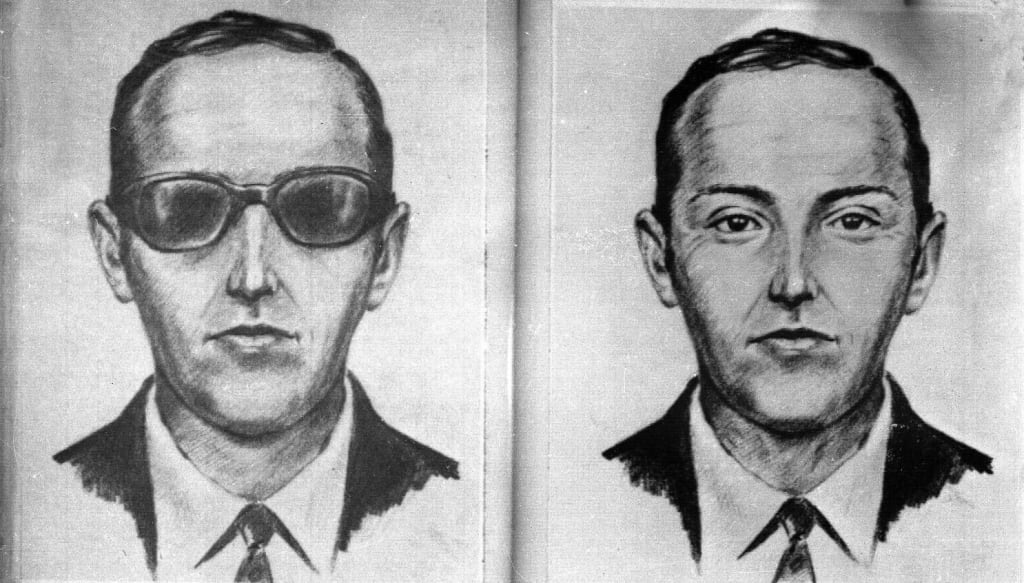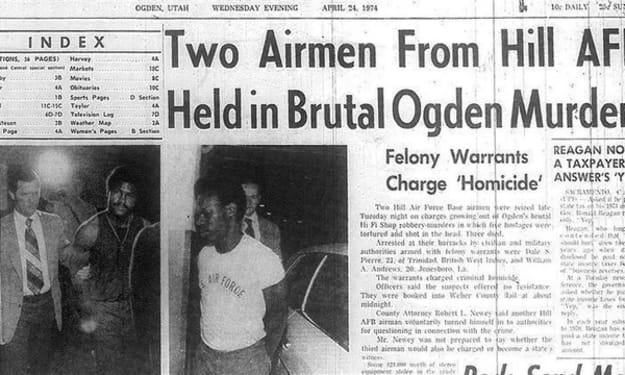The Enigma of D.B. Cooper: The Unsolved Mystery of the Skyjacker
Examining the Case, Theories, and Legacy of the Elusive Criminal

On November 24, 1971, a man who identified himself as Dan Cooper, later known as D.B. Cooper, hijacked Northwest Orient Airlines Flight 305 from Portland, Oregon to Seattle, Washington. Cooper claimed to have a bomb and demanded a ransom of $200,000 in cash and four parachutes. After the ransom was delivered and the passengers and some of the crew were released, Cooper ordered the remaining crew to take off and fly to Mexico City at a low altitude and with the rear staircase lowered. However, somewhere over the rugged terrain of southwestern Washington, Cooper jumped out of the plane with a parachute and the ransom money, and vanished into thin air. The case of D.B. Cooper has remained one of the most enduring and mysterious unsolved crimes in American history, inspiring countless theories, investigations, and cultural references.
The Hijacking
The hijacking of Flight 305 began innocuously enough, with a man in his mid-40s boarding the plane in Portland under the name of Dan Cooper, using cash to buy a one-way ticket to Seattle. Cooper wore a dark suit, a black tie, a white shirt, and a raincoat, and carried a briefcase and a paper bag. He took a seat in the rear of the Boeing 727, smoking a cigarette and ordering a bourbon and soda. About 30 minutes after takeoff, Cooper handed a note to Florence Schaffner, a flight attendant sitting nearby, and told her to read it without drawing attention to herself. The note said, "I have a bomb in my briefcase. I want you to sit by me." Schaffner saw a glimpse of wires and red sticks inside the briefcase and asked to see the bomb, which Cooper opened slightly to reveal eight red cylinders, a tangle of wires, and a battery. Cooper then told Schaffner to write down his demands, which included $200,000 in "negotiable American currency," four parachutes (two primary and two reserve), and a fuel truck standing by in Seattle to refuel the plane upon arrival. Cooper warned that he would blow up the plane if his demands were not met or if anyone tried to interfere.
The plane landed in Seattle-Tacoma International Airport at 5:39 pm, where the ransom and parachutes were delivered to Cooper in exchange for the release of the passengers and some of the crew. Cooper instructed the remaining crew to take off and fly southward at a maximum altitude of 10,000 feet, with the flaps and landing gear down and the rear staircase lowered. Cooper also demanded that the cabin remain unpressurized and the cockpit be dimly lit. The plane took off at 7:40 pm, with Cooper and four crew members as the only occupants. After about 30 minutes of flying, Cooper apparently jumped out of the plane with a parachute and the ransom money, leaving behind only some clues and mysteries.
The Investigation
The hijacking of Flight 305 triggered one of the largest and most intensive manhunts in U.S. history, involving the FBI, the Air Force, the Army, and the National Guard, as well as hundreds of volunteers and searchers. The FBI launched an investigation that lasted for years and involved thousands of leads, suspects, and interviews. The FBI conducted aerial and ground searches of the area where Cooper was believed to have jumped, recovered some of the ransom money in 1980, and conducted DNA tests and other forensic analyses on various pieces of evidence. However, no conclusive evidence of Cooper's identity or whereabouts was ever found, and the case remained open and unsolved.
The Clues and Theories
The case of D.B. Cooper has generated numerous clues and theories over the years, some more plausible than others. Some of the most prominent clues and theories are:
The Parachute Jump
The most crucial clue in the case of D.B. Cooper is the parachute jump itself. Cooper apparently jumped out of the plane over the rugged terrain of southwestern Washington, in an area known as the Cooper Vortex, where the Columbia River Gorge meets the foothills of the Cascade Range. The jump was made in the dark, in bad weather conditions, and at a low altitude, which made it extremely dangerous and difficult. Cooper was not a trained skydiver, and the parachutes he had were military-style, which required skill and experience to use properly. Moreover, Cooper was carrying the ransom money, which would have added weight and bulk to his jump. The fact that Cooper survived the jump, assuming he did, is remarkable, and has led to many theories about his identity and background.
The Ransom Money
Another key clue in the case of D.B. Cooper is the ransom money itself. The $200,000 in cash was unmarked, non-sequential bills, which were recorded by the FBI before being handed over to Cooper. The bills were supposed to be traceable, but none of them have ever turned up in circulation or been linked to any legitimate bank or business. Some of the bills were discovered in 1980 by a boy on the banks of the Columbia River, about 20 miles from where Cooper was believed to have jumped. The bills were in poor condition and had been scattered by the elements, but they were positively identified as part of the ransom money. The discovery of the bills raised more questions than answers, such as whether Cooper died in the jump, whether he buried some of the money, or whether he laundered it somehow.
The Suspects
The case of D.B. Cooper has attracted a wide range of suspects, from ordinary citizens to military veterans, from petty criminals to intelligence agents. Some suspects have been eliminated by alibis, physical evidence, or DNA testing, while others remain intriguing or suspicious. Some of the most notable suspects are:
Robert Rackstraw, a former Army paratrooper and pilot who had a criminal record and resembled the composite sketch of Cooper. Rackstraw was investigated by the FBI in the 1970s and again in the 2010s, but was never charged. Rackstraw denied being Cooper and claimed that he was framed by the government.
Kenneth Christiansen, a former Northwest Airlines flight attendant who had a background in military intelligence and was rumored to have a gambling problem. Christiansen was named as a suspect by a private investigator in 2007, based on circumstantial evidence and eyewitness testimony. Christiansen died in 1988, but his family denied his involvement in the hijacking.
Duane Weber, a former career criminal and ex-convict who confessed to his wife on his deathbed in 1995 that he was Cooper. Weber's wife reported his confession to the FBI, but his claims were dismissed as unreliable and lacking evidence. Weber had a striking resemblance to the composite sketch of Cooper and had lived in the Pacific Northwest in the 1970s.
Richard McCoy, a former Army helicopter pilot and skydiver who hijacked a United Airlines flight in 1972 using a similar modus operandi as Cooper. McCoy was arrested and sentenced to prison, but escaped and was later killed in a shootout with the FBI. McCoy was considered a strong suspect in the Cooper case, but his DNA did not match the samples from Cooper's tie.
The Theories (continued)
Cooper died in the jump: This theory suggests that Cooper did not survive the parachute jump and died of injuries or exposure in the wilderness. The fact that no trace of Cooper's body or the parachute has been found supports this theory. However, it is also possible that Cooper's body was simply not found due to the rugged terrain, the dense forest, or the limited search efforts.
Cooper escaped and lived a new life: This theory proposes that Cooper successfully escaped with the ransom money and disappeared, either by changing his identity or leaving the country. Supporters of this theory point to the unmarked bills, the lack of credible suspects, and the possibility of Cooper having accomplices or contacts outside the US. However, it is also possible that Cooper was caught or killed soon after the jump, or that he spent the rest of his life in hiding or poverty.
Cooper was a government agent or operative: This theory suggests that Cooper was not a lone criminal, but rather a trained or hired agent working for the government, the military, or a secret organization. Supporters of this theory point to the unusual demands and behavior of Cooper, such as his choice of plane and crew, his knowledge of the terrain and weather, and his cool and calculated demeanor. However, there is no hard evidence to support this theory, and many experts consider it unlikely or far-fetched.
Cooper was a hoax or a legend: This theory proposes that the D.B. Cooper hijacking was not a real crime, but rather a staged event or a fictional story that became popularized and embellished over time. Supporters of this theory point to the lack of reliable eyewitnesses, the discrepancies in the descriptions and accounts of Cooper, and the absence of any verifiable proof of the hijacking or the ransom money. However, this theory is also controversial and lacks concrete evidence.
Conclusion
The case of D.B. Cooper remains one of the most intriguing and enduring mysteries in American criminal history. Despite numerous investigations, leads, and theories, the identity and fate of Cooper remain unknown and elusive. The case has inspired books, movies, documentaries, and countless speculations, but it has also raised serious questions about the nature of justice, law enforcement, and human nature. Whether Cooper was a daring criminal, a clever spy, or a tragic victim, his legacy will continue to fascinate and perplex people for years to come.
About the Creator
Arish Ali
The world is yours!
Enjoyed the story? Support the Creator.
Subscribe for free to receive all their stories in your feed. You could also pledge your support or give them a one-off tip, letting them know you appreciate their work.





Comments
There are no comments for this story
Be the first to respond and start the conversation.